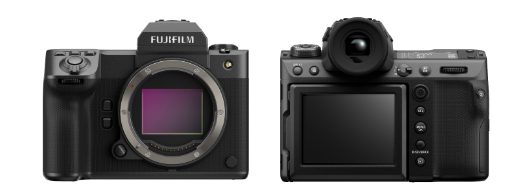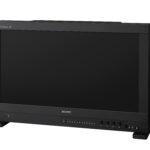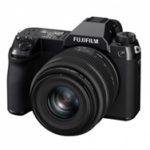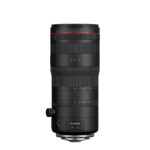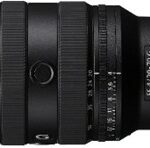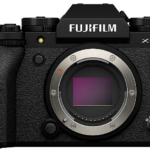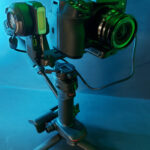The new flagship featuring the newly developed high-speed 102MP sensor GFX 102MP CMOS II HS and the X-Processor 5Equipped with a Large Format sensor 1.7 times the size of a Full Frame sensor and delivering the highest burst-shooting, AF and video performance in the history of the GFX System
FUJIFILM Australia has announced the launch of the mirrorless digital camera “Fujifilm GFX100 II” (GFX100 II). It will be the latest addition to the GFX System of mirrorless digital cameras incorporating the Large Format image sensor*1 approximately 1.7 times larger than a 35mm full frame sensor.
The GFX100 II features the newly developed 102MP high-speed image sensor “GFX 102MP CMOS II HS” and the high-speed image processing engine “X-Processor 5” to deliver up to double the signal readout speed compared to the current model*2. It is a new flagship model of the GFX System that provides significant performance improvement in continuous shooting, AF and video recording.
The GFX100 II boasts superior image quality thanks to the use of the Large Format sensor that produces rich tonal reproduction and strong three-dimensional definition. In addition, the latest high-speed image sensor coupled with the high-speed image processing engine has made it possible to bring the AI-based subject-detection AF developed with Deep Learning technology as well as the latest prediction AF algorithm, developed with the X-H2S, to the GFX System for the first time. The burst shooting performance has also improved from the current*4 5.0 frames per second to 8.0 frames per second*3 to broaden the scope of genres. The GFX System excels in fashion, commercial and landscape categories to sports and news photography, where high-speed performance is essential.
The new sensor has also led to significant enhancement of video recording performance. The camera can record 4K/60P 4:2:2 10-bit video internally and supports 8K/30P video for the first time in the GFX System. It also offers the new “Video Format” modes to take advantage of the Large Format sensor’s characteristics. GFX100 II supports various cine recording formats, including Premista, 35mm, and anamorphic (35mm) with the mount adapter. This accommodates video recording in a versatile range of situations, complemented additionally by the enhanced sensor readout speed and the tracking AF.
Additional features have been added to system expandability. The GFX100 II body features an Ethernet port as well as HDMI Type A and USB-C terminals for added connectivity of external devices. Support for the cloud service “Frame.io Camera to Cloud” and timecode sync with ATMOS AirGlu™*5 BT streamlines the users’ workflow.
Image quality has also been enhanced with the introduction of non-extended ISO80 sensitivity and the Film Simulation mode “REALA ACE.” Hardware improvements include the up to 8-stop*6 five-axis in-body image stabilisation (IBIS), 1.0x viewfinder magnification, and 9.44-million-dot high-magnification and high-definition EVF. The camera body’s new design features include a large sub-LCD, tilted top panel and a new textured finish. The GFX100 II represents an evolution from the current model in all areas to cater to the needs of professional photographers and videographers.
“The new GFX100 II is a flagship camera that is going to change the way that photographers and videographers view Large Format Digital. No longer will they have to choose between fast shooting, image resolution or video performance, the GFX100 II has it all.” said Shaun Mah, General Manager of the Electronic Imaging & Optical Devices Division of FUJIFILM Australia. “We are continuing to invest in our GFX System as we believe it is the future of photography and videography.” added Mah.
*1 An image sensor measuring 55mm diagonally (43.8mm x 32.9mm) with the area approximately 1.7 times that of a 35mm full-frame sensor.
*2 Compared to the sensor in the GFX100S.
*3 When using the mechanical shutter.
*4 Compared to the GFX100S.
*5 AirGlu™ is a trademark and a registered trademark of Atomos.
*6 Compliant with CIPA in pitch / yaw directions when mounted with the Fujinon Lens GF63mmF2.8 R WR.
- Fujifilm GFX100 II Product Features
Highest burst shooting and AF performance in the history of the GFX System thanks to the all-new high-speed image sensor ”GFX 102MP CMOS II HS” and the high-speed image processing engine “X-Processor 5”
- The GFX100 II is equipped with the newly developed 102MP image sensor “GFX 102MP CMOS II HS” that boasts up to double the signal readout speed compared to the current model to enable continuous shooting of up to 8.0 frames per second. Users can enjoy burst shooting at quick intervals, thanks to the reinforced buffer memory. In the field of sports photography, previously difficult with past GFX System models, the GFX100 II seizes decisive photo moments while preserving the high definition and high image quality synonymous with the Large Format sensor.
- The use of an improved algorithm has evolved the Face / Eye AF and introduced the AI-based subject-detection AF, developed with Deep Learning technology. The power of AI means the camera can now detect animals, birds, cars, motorcycles, bicycles, airplanes, trains, insects, and drones*7. A detected subject is automatically tracked while kept in focus so that users can focus on shutter timing and framing. The evolved predictive AF algorithm provides added ease to users in genres requiring advanced tracking capability for fast-moving subject, such as sports photography.
- The camera is equipped with a high-magnification and high-definition 9.44-million-dot EVF with 1.0x magnification. It suppresses parallax and distortion, which typically occurs when an eye position becomes displaced while using the viewfinder, thereby providing outstanding visibility through the EVF. The EVF boasts a smooth refresh frame rate of approx. 120fps to accurately identify a subject’s fast movements.
- The camera’s Zone AF function can now be customised. The shape of the AF area can be adjusted to suit a shooting situation for more accurate autofocusing.
*7 Use the “Bird” setting to detect insects and the “Airplane” setting to detect drones.
Broader scope of stills expressions with the non-extended ISO80 sensitivity and the new Film Simulation mode “REALA ACE”
- Improvement to the pixel structure has boosted the new sensor’s saturated electrons, thereby allowing the use of ISO80 as a standard sensitivity. When the sensor sensitivity is set at ISO80, the camera can capture images at a greater dynamic range and lower noise than with the previous model*8.
- The new sensor’s microlenses are improved to increase light gathering efficiency across the sensor’s edges, thus improving image quality at edges and AF accuracy over the previous model.
- The GFX100 II comes with a total of 20 Film Simulation modes including the new “REALA ACE” to give images a diverse range of distinctive tones. “REALA ACE” offers faithful colour reproduction and high-contrast tonality, making it suitable for any subject and situations.
- The camera features the Pixel Shift Multi-Shot function, which enables 4x resolution and accurate colour reproduction. The IBIS mechanism is precisely controlled to shift the image sensor by 0.5 pixel and shoot 16 RAW images in quick succession. The dedicated software “Pixel Shift Combiner” is then used to combine the 16 RAW files to generate a 400MP image. This is a perfect choice for commercial photography or digital archiving of cultural assets.
- The camera supports the HEIF file format, which provides 10-bit colour depth while keeping the file size to 70% of JPEG data to enable image storage of greater image quality and efficiency.
*8 When recording at 16-bit RAW.
Extensive video performance that caters to the needs of professional video production
- The use of the new sensor has given the ability to record 4K/60P video and even 8K/30P 4:2:2 10-bit video internally. The sensor readout speed has been increased to suppress the rolling shutter effect for natural filming of a moving subject. ISO100 is also available in the video mode for filming of even higher image quality.
- The GFX100 II supports three Apple ProRes*9 codecs, i.e. Apple ProRes 422 HQ, Apple ProRes 422 and Apple ProRes 422 LT. When shooting in Apple ProRes, the camera can use proxy video recording such as Apple ProRes 422 Proxy, which reduces video editing workload to streamline the overall workflow from filming to post-production.
- GFX100 II supports various cine recording formats, including Premista, 35mm, and anamorphic (35mm) with the mount adapter, accommodating a variety of video expressions.
- The tracking AF function for video recording has been added. Users can touch the screen to specify a subject to be tracked while filming in the AF-C + Wide / Tracking AF mode. This allows the camera to track the right subject in situations where multiple subjects are in the frame.
- This is the first GFX System camera that features F-Log2 with dynamic range expanded up to 14+ stops*10. This addition enables video recording with enriched tonality, thereby broadening post-production potential significantly.
- The GFX100 II can output up to 8K/30P 12-bit video in RAW data via HDMI. The camera can record video in the Apple ProRes RAW format when used with the NINJA V+ monitor by ATOMOS, and in the Blackmagic RAW format when used with the Video Assist 12G monitor by Blackmagic Design.
- The camera supports timecode sync with ATOMOS AirGlu™ BT. This enables seamless timecode syncing with multiple cameras, meeting demand from various video production sites.
- The following functions are newly featured to make video shooting easy:
- Displaying waveform vectorscope
- Adding the new MF-assist function focus map
- Adding F-log2 D Range Priority mode*11
*9 Apple ProRes is a trademark of Apple Inc. registered in the United States and other countries.
*10 When using the F-log2 D Range Priority mode, according to in-house measurement by Fujifilm.
*11 Available only when using the GF/Premista mode at DCI4K/4K and 29.97P/25P/24P/23.98P; This may produce the rolling shutter effect.
Extensive system expandability
- The camera body is equipped with an Ethernet port as well as HDMI Type A and USB-C terminals to expand connectivity with external devices significantly for diverse peripheral combinations.
- An external SSD can be connected via USB-C to record stills and video data directly in the external SDD in any mode or format including 4K/60P and 8K/30P. *12
- The camera supports the cloud service “Frame.io Camera to Cloud” so that Apple ProRes Proxy files and a variety of other video files can be uploaded directly to Frame.io, thus dramatically streamlining the workflow from shooting to editing.
- The camera is equipped with dual card slots supporting CFexpressTM Type B and SD cards. The use of a CFexpressTM Type B card with a fast write speed brings out the full video performance of the GFX100 II.*13 *14
- IPTC meta data*15 can be added to images as they are shot. The meta data can be checked and edited in the digital camera app “FUJIFILM XApp.”
*12 Depending on the type of SSD, there are some modes and formats that cannot be recorded. Please check the compatibility list for SSD.
*13 CFexpress is a trademark or registered trademark of The CompactFlash Association.
*14 See Fujifilm’s website for a list of compatible cards that have been confirmed to operate correctly.
*15 IPTC meta data refers to meta data contained in digital images compliant with the standards set by the IPTC (International Press Telecommunications Council).
Hardware that provides powerful shooting support and design that epitomises functional beauty
- The GFX100 II has a new IBIS mechanism that enhances stabilisation accuracy by using image information to detect camera shake. The result is up to eight-stop five-axis stabilisation performance, the best among Fujifilm cameras. Users can shoot hand-held with ease even in low light situations such as night landscapes. This IBIS mechanism is also used to shift the image sensor at high precision to produce approx. 400MP images in the Pixel Shift Multi-Shot function.
- The camera body has been designed with multiple improvements over previous models in pursuit of practicality. The new BISHAMON-TEXTM*16 texture is used to maximise the camera’s grip when hand-held in various angles. The top panel is slightly slanted toward a user so that camera settings can be checked with a very quick glance. The sub-LCD monitor at the top is larger than previous models with updated GUI design for enhanced visibility and readability.
- The operability of various buttons has been improved. Three Fn buttons with advanced operability are positioned at the top of the grip to ensure error-free camera operations when shooting conditions change.
*16 BISHAMON-TEX is a trademark or registered trademark of FUJIFILM Corporation.
- Optional accessory
Vertical battery grip “VG-GFX II” (designed for the GFX100 II)
- This battery grip is dust and weather resistant and capable of operating at temperatures as low as -10℃. It can hold two of the large capacity battery “NP-W235.”
- Buttons are placed at accessible places for shooting as easily and comfortably as when the camera is held horizontally.
Cooling fan “FAN-001” (designed for the GFX100 II, X-H2S, X-H2 and X-S20)
- A cooling fan that assists video filming for extended duration or under high-temperature environment.
- It can be attached to the rear side of the camera body and receive power completely cable-free to extend the duration of continuous video filming at high temperatures without concerns of heat-related malfunction.
- Product name, release date and price
| Product name | Release date | RRP (including GST) |
| Fujifilm GFX100 II | 26th September, 2023 | $12,599 |
| VG-GFX100 II VERTICAL GRIP | 26th September, 2023 | $899 |
FUJIFILM AUSTRALIA ANNOUNCES NEW FUJINON GF55mmF1.7 R WR
FUJIFILM Australia Pty Ltd has announced the launch of the “FUJINON GF55mmF1.7 R WR” (GF55mmF1.7 R WR). The new lens joins the line-up of GF lenses: interchangeable lenses for the GFX Series of Fujifilm’s mirrorless digital cameras equipped with the Large Format sensor*1 measuring 1.7 times that of the 35mm full-frame sensor.

(FUJINON GF55mmF1.7 R WR)
The GF55mmF1.7 R WR is a large-aperture prime lens with the standard focal length of 55mm (equivalent to 44mm in the 35mm film format). The Large Format’s enriched descriptive capability is combined with the creamy bokeh characteristic of the large maximum aperture, making the main subject stand out against blurred background. The lens’ focal length gives the field of view close to that of human vision to create a natural perspective. This makes it ideal for information dense snapshots to capture how the main subject relates to the background, as well as portraiture with a tack-sharp subject against beautiful bokeh. The focal length of 55mm is the same as the diagonal measurement of GFX Series’ signature large-format sensor, which has the dimensions of 43.8mm x 32.9mm. The large-aperture GF55mmF1.7 R WR prime lens is a new addition to Fujifilm’s line-up of interchangeable lenses that brings out the best in large format cameras.
The GF55mmF1.7 R WR consists of 14 lens elements in 10 groups including two ED elements and two aspherical elements to deliver a high level of image-resolving performance and smooth bokeh. The lens features optimally positioned aspherical elements and makes a generous use of the eight-element focusing lens group including one of the aspherical elements and two ED elements. This effectively controls shifts in chromatic aberration, spherical aberration and comatic aberration when the focusing position changes to deliver a pleasant background blur and advanced image-resolving performance, characteristics of large-aperture lenses. The maximum aperture of F1.7 and the generous composition of 14 lens elements in 10 groups are complemented with the use of a Large Format image sensor to create creamy bokeh and advanced descriptive capability. The lens has a focal length close to the human eye, making it highly versatile in all shooting situations. Users can enjoy the full appeal of the large-format sensor in genres ranging from day-to-day snapshots to full-fledged portraiture both indoors and outdoors.
“The new GF55mmF1.7 R WR rounds out our trilogy of fast zoom lenses available for the GFX Series. Offering a view close to what the human eye sees, this allows more natural looking portraits, and incredible low light performance.” said Shaun Mah, General Manager of the Electronic Imaging & Optical Devices Division of FUJIFILM Australia.
*1 An image sensor measuring 55mm diagonally (43.8mm x 32.9mm) with the area approximately 1.7 times that of a 35mm full-frame sensor.
- FUJINON GF55mmF1.7 R WR Product Features
Advanced image-resolving performance and beautiful bokeh
- The aspherical elements have been produced at ultra-high precision to minimise the onion-ring effect by using a mould processed at a tolerance of 1/100,000th of a millimetre. One of these elements are positioned just behind the aperture ring to control spherical aberration while softening the background blur. The other aspherical element is placed at the back, closer to the lens mount, to control rays of light to achieve edge-to-edge sharpness.
- The focusing lens group generously features eight elements including one aspherical element and two ED elements to achieve advanced image-resolving performance across the entire focusing range. Axial chromatic aberration is minimised to create soft and beautiful bokeh with subdued colour tones. This has enhanced the quality of bokeh, which is a characteristic of large-aperture lenses used on a Large-Format sensor.
- High refractive elements that suppress aberration fluctuation, typically used in cinema camera lenses, are used as the front element, and also in the focusing group to reduce aberration. This controls spherical aberration and reduces performance shifts that occur with the movement of the focusing group to maintain advanced image-resolving performance regardless of focusing positions.
- This is the first GF lens to use 11 diaphragm blades to achieve a near-perfect circle in the aperture*2. This is how the lens can produce rounded bokeh even when the lens is stopped down slightly from being wide open, creating beautiful bokeh in a wide variety of photographic scenes.
*2 As of September 12, 2023.
Freedom of shooting at the normal focal length thanks to the large aperture
- The lens has a normal focal length of 55mm (equivalent to 44mm in the 35mm film format), making it highly versatile in all shooting situations. Users can enjoy the full appeal of the Large Format sensor in genres ranging from casual day-to-day snapshots to street photography that captures how the main subject relates to the background, taking full advantage of the large maximum aperture of F1.7.
AF function driven by an evolved DC motor for fast and accurate autofocus
- The GF55mmF1.7 R WR uses a DC motor that precisely controls the focusing group containing the aperture unit and eight elements that provide advanced image-resolving performance and beautiful bokeh. The motor allows the lens to autofocus on the subject quickly and accurately, even when shooting with a shallow depth-of-field, to ensure users capture decisive photo opportunities.
Dust and Weather Resistance and capability of operating at -10℃ for enhanced practical usability
- The lens barrel is weather-sealed in nine places to ensure dust and weather resistance, and the ability to operate at temperatures as low as -10℃. This means users can enjoy the lens with peace of mind while taking photos outdoors in light rain or in dusty outdoor places.
- The use of ultra-high-precision aspherical elements and optimised lens design mean this lens only weighs 780g and measures 99.3mm in length despite being a larger-aperture Large Format lens with the maximum aperture of F1.7. This reduces users’ strains in walking around with the lens mounted on a camera, adding an extra sense of mobility as a standard walkaround lens.
- Product name, release date and price
| Product name | Release date | RRP (including GST) |
| FUJINON GF55mmF1.7 R WR | 26th September, 2023 | $3,899 |
FUJIFILM AUSTRALIA ANNOUNCES NEW FUJINON GF30mmF5.6 T/S AND FUJINON GF110mmF5.6 T/S MACRO
The long-awaited Tilt Shift lenses for the GFX System, catering to professional shooting needs with GFX System’ superior image quality
FUJIFILM Australia Pty Ltd has announced the launch of the “FUJINON GF30mmF5.6 T/S” (GF30mmF5.6 T/S) and the tilt shift macro lens “FUJINON Lens GF110mmF5.6 T/S Macro” (GF110mmF5.6 T/S Macro). The new lenses, capable of tilt-shift photography, join the line-up of GF lenses: interchangeable lenses for the GFX System of Fujifilm’s mirrorless digital cameras equipped with the Large Format sensor*1 measuring 1.7 times that of the 35mm full-frame sensor.

(FUJINON GF30mmF5.6 T/S) (FUJINON GF110mmF5.6 T/S Macro)
The GF30mmF5.6 T/S and GF110mmF5.6 T/S Macro offers the tilt function of tilting their optical axis and the shift function of moving their optical axis in parallel to alter how the optical axis relates to the imaging plane and intentionally manipulate areas in focus and perspective. This caters to the needs of professional photographers who want to explore composition and shooting positions freely in architecture, landscape, and commercial photography. The tilt shift lenses feature optical design that secures approx. 85mm image circle to cover the range of shift adjustment up to ±15mm. The revolving operation of changing tilting and shifting directions is combined with the T/S revolving operation, in which the tilting mechanism is revolved to adjust the tilting and shifting directions to any angle from perpendicular to parallel, to enable the specialised shooting style while preserving the superior image quality of the GFX System.
The GF30mmF5.6 T/S is a wide-angle tilt shift lens with the focal length of 30mm (equivalent to 24mm in the 35mm film format). It suppresses distortion and ghosting, typically seen with wide-angle lenses, to achieve a high level of image resolution. This lens meets professional needs in landscape photography where everything within the frame is in focus from grass in the foreground to distant mountains, or in architectural photography with distortion characteristically seen when shooting tall architectures is corrected.
The GF110mmF5.6 T/S Macro is a mid-telephoto tilt shift macro lens with the focal length of 110mm (equivalent to 87mm in the 35mm film format) and maximum reproduction rate of 0.5x. It suppresses various types of aberration including distortion, lateral chromatic aberration, and axial chromatic aberration to achieve an advanced level of image resolution. The focal position of a subject in close-up can be controlled freely to meet the needs of commercial photography.
Coinciding the announcement of these products, Fujifilm has also unveiled the development roadmap for GF lenses, featuring new additions including a highly requested ultra-telephoto prime lens and a power zoom lens that can broaden the scope of video expressions.
“The new Tilt Shift lenses embodies our commitment to our users. No longer do photographers and videographers have to seek out third party solutions for perspective control solutions for the GFX System.” said Shaun Mah, General Manager of the Electronic Imaging & Optical Devices Division of FUJIFILM Australia.
*1 An image sensor measuring 55mm diagonally (43.8mm x 32.9mm) with the area approximately 1.7 times that of a 35mm full-frame sensor.
- Product Features
Wide-angle tilt shift lens “GF30mmF5.6 T/S”
Advanced optical design that minimises various forms of aberration while delivering superior image resolving performance
- The lens consists of 16 lens elements in 11 groups including three aspherical elements, two ED elements and one Super ED element. Its generous configuration featuring the use of a large aperture aspherical element as the front element as well as three ED elements provides advanced optical design that eliminates the need for electronically correcting distortion and lateral chromatic aberration. Spherical aberration, comatic aberration and field curvature are suppressed to the extreme extent to achieve edge-to-edge sharpness even during shifting.
- The use of Fujifilm’s unique Nano GI Coating technology controls refractive index on the lens surface moderately to inhibit unnecessary light reflection and reduce ghosting and flare, which are typically seen in wide-angle lenses.
Tilting and shifting mechanisms that make most of the benefits of the large format sensor
- Tilting of ±8.5° and shifting of up to ±15mm control the focal plane and perspective of the subject. The revolving operation of changing tilting and shifting directions within ±90° is combined with the T/S revolving operation, where the angle of tilting and shifting direction can be adjusted from perpendicular to parallel within 0°- 90° to give a high level of shooting freedom.
- The lens has a built-in sensor that detects the degree of shifting and revolving movements. This data can be checked in Live View and is recorded into image data so that it can be used during RAW processing*2.
Compact design that considers ease of use during shooting
- Wide-angle lenses tend to be large. However, this lens has kept the optical system that covers approx. 85mm image circle at just 138.5mm in length and 1.340g in weight by optimally positioning 16 lens elements in 11 groups, including aspherical elements and ED elements. Furthermore, a large aperture aspherical element is used as the front element to keep the lens’s filter thread to versatile 105mm*3, allowing users to use a variety of filters to suit situations including landscape.
- The lens comes with a tripod collar, specifically designed for it. Even during shifting, the collar helps maintain the subject’s position in relation to the lens to prevent parallax and facilitates accurate stitching of multiple images.
*2 The function may be used with the simultaneously released “FUJIFILM GFX100 II”. Future firmware update is required for the FUJIFILM GFX100, FUJIFILM GFX100S, FUJIFILM GFX50S II, FUJIFILM GFX 50S and FUJIFILM GFX 50R.
*3 Use the supplied adapter ring to use a 105mm filter.
Mid-telephoto tilt shift lens “GF110mmF5.6 T/S Macro”
Optical design that produces incredible image sharpness
- This lens consists of 11 lens elements in nine groups including one aspherical element and two ED elements. The aspherical element controls comatic aberration and field curvature while the ED elements minimise axial chromatic aberration. Furthermore, the lens configuration, with the aperture midway, suppresses distortion and lateral chromatic aberration to achieve edge-to-edge sharpness without relying on electronic correction.
- This lens achieves the maximum magnification ratio of 0.5x for close-up photography. Users can enjoy free focal control by tilting up close to the subject, a feature useful in commercial photography for subjects such as still life.
Tilting and shifting mechanisms that make most of the benefits of the large format sensor
- Tilting of ±10°and shifting of up to ±15mm control the focal plane and perspective of the subject. The revolving operation of changing tilting and shifting directions within ±90° is combined with the T/S revolving operation, where the angle of tilting and shifting direction can be adjusted from perpendicular to parallel within 0°- 90° to give a high level of shooting freedom.
- The lens has a built-in sensor that detects the degree of shifting and revolving movements. This data can be checked in Live View and is recorded into image data so that it can be used during RAW processing*2.
Compact design that reduces burden during shooting
- This lens measures 149mm and weighs 1,255g with the filter thread size of 72mm. It uses a focus system that extends out the front group in order to keep the overall lens size compact.
- Close attention has been paid to designs of operation sections to achieve a highly functional design that reduces users’ burden during extended shooting.
- Product name, release date and price
| Product name | Release date | RRP (including GST) |
| FUJINON GF30mmF5.6 Tilt Shift | October, 2023 | $6,799 |
| FUJINON GF110mmF5.6 Tilt Shift Macro | November, 2023 | $5,899 |

